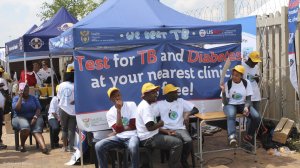Medical incapacity, occupational diseases major challenges for mining sector



WORRYING TRENDS With the exception of tuberculosis, which has been declining since 2012, the number of mine employees with diabetes, hypertension and HIV is steadily increasing
THUTHULA BALFOUR-KAIPA There is ‘great suspicion’ on all sides regarding the grounds upon which employees are deemed to be medically incapacitated
Photo by Duane Daws
Medical incapacity is a major challenge for the South African mining industry and continues to be a bone of contention between employers, employees and the Department of Mineral Resources (DMR), says Chamber of Mines of South Africa (CoM) health adviser Dr Thuthula Balfour-Kaipa.
She says that there is “great suspicion” on all sides regarding the grounds on which employees are deemed to be medically incapacitated and the resultant change in livelihood for employees. This is integrally linked with medical incapacity and absenteeism, which both have an impact on the productivity of employees.
A study by the US Chamber of Commerce in 2015 indicated that the economic impact of absenteeism, ‘presenteeism’ (the action of employees coming to work despite having a sickness that justifies an absence, resulting in them performing suboptimally) and early retirement resulted in South Africa losing 6.8% in gross domestic product (GDP) revenues.
Balfour-Kaipa notes that the same study shows that, in spite of different circumstances, most countries face three challenges, namely that their populations are ageing; there is a high prevalence of noncommunicable diseases (NCDs); and many risk factors for the future incidence of NCDs are high and in some cases are continuing to rise.
She also points out that the CoM in 2015 conducted a survey on medical incapacity, medical morbidity and mortality, as well as absenteeism among chamber members. “The aim of the survey was to quantify the extent of the problem, characterise the problem and find possible reasons for medical incapacity and absenteeism.”
The survey gathered and interpreted responses on medical incapacity, chronic and occupational diseases, and medical mortality of permanent employees and contractors at mines from 2009 to 2014. Primary data for the quantitative survey was collected during October 2015, using structured questionnaires sent to all chamber members. The responses were then collated and analysed.
Balfour-Kaipa comments that the results showed that the total number of employees in service peaked in 2012 at 374 368 from 349 346 employees in 2009, decreasing to 360 879 in 2014. There was an average percentage split of 74:26 between permanent employees and contractors during this period. She says that, overall, respondents advised that, in 2014, 88.7% (271 509) of the mining sector’s employees were male and 11.3% (34 653) female.
Balfour-Kaipa points out that, with the exception of tuberculosis (TB), which has exhibited a downward trend since 2012, the number of employees with diabetes, hypertension and HIV is steadily increasing. In 2014, employees living with HIV accounted for 45% (40 437) of all chronic cases reported, while hypertension accounted for 42% (38 077) of all cases. Diabetes accounted for 9% (7 868) and employees diagnosed with TB stood at 4% (3 843) of the workforce.
Further, she notes that occupational diseases such as noise- induced hearing loss, silicosis, pneumoconiosis and occupational TB all showed a decline over the years.
However, Balfour-Kaipa highlights that from 2009 to 2014, the average overall absenteesim rates gradually increased from 15.7% to 17.8%. Medical absenteesim rates also showed a similar increase, from 5.1% in 2009 to 6%, in 2014.
She comments that, on average, 75% of all cases referred for medical incapacity were approved as medical incapacity cases and, since 2011, there has been an increase in the number of cases referred for medical incapacity.
Moreover, Balfour-Kaipa remarks that, since 2009, there have been a total of 8 829 deaths at mines owing to occupational diseases, with the highest number of deaths occurring in 2012 at 1804. However, she cautions that this number may well be significantly higher, as many mines do not report these figures.
“Therefore, comprehensive pro- grammes that support total employee wellness should form the basis of health interventions for mining companies going forward,” Balfour-Kaipa concludes.
Comments
Press Office
Announcements
What's On
Subscribe to improve your user experience...
Option 1 (equivalent of R125 a month):
Receive a weekly copy of Creamer Media's Engineering News & Mining Weekly magazine
(print copy for those in South Africa and e-magazine for those outside of South Africa)
Receive daily email newsletters
Access to full search results
Access archive of magazine back copies
Access to Projects in Progress
Access to ONE Research Report of your choice in PDF format
Option 2 (equivalent of R375 a month):
All benefits from Option 1
PLUS
Access to Creamer Media's Research Channel Africa for ALL Research Reports, in PDF format, on various industrial and mining sectors
including Electricity; Water; Energy Transition; Hydrogen; Roads, Rail and Ports; Coal; Gold; Platinum; Battery Metals; etc.
Already a subscriber?
Forgotten your password?
Receive weekly copy of Creamer Media's Engineering News & Mining Weekly magazine (print copy for those in South Africa and e-magazine for those outside of South Africa)
➕
Recieve daily email newsletters
➕
Access to full search results
➕
Access archive of magazine back copies
➕
Access to Projects in Progress
➕
Access to ONE Research Report of your choice in PDF format
RESEARCH CHANNEL AFRICA
R4500 (equivalent of R375 a month)
SUBSCRIBEAll benefits from Option 1
➕
Access to Creamer Media's Research Channel Africa for ALL Research Reports on various industrial and mining sectors, in PDF format, including on:
Electricity
➕
Water
➕
Energy Transition
➕
Hydrogen
➕
Roads, Rail and Ports
➕
Coal
➕
Gold
➕
Platinum
➕
Battery Metals
➕
etc.
Receive all benefits from Option 1 or Option 2 delivered to numerous people at your company
➕
Multiple User names and Passwords for simultaneous log-ins
➕
Intranet integration access to all in your organisation




















